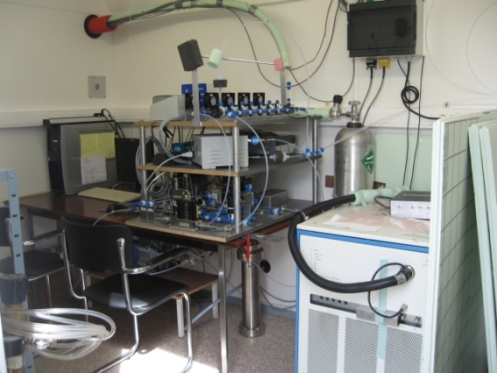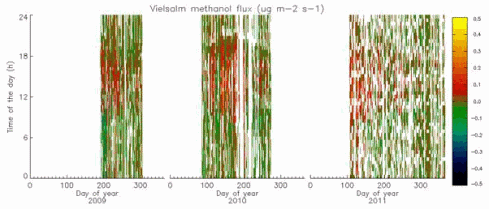La traque aux composés organiques volatils: Lire l’article ou télécharger l’article
Context
Natural ecosystems are important Volatile Organic Compounds (VOC) emitters. At global scale, these emissions of biogenic origin (BVOC) represent 1150 Tg C per year, almost ten times more than anthropic emissions of VOC (Guenther et al. 1995).
BVOC are emitted by plants for protection against diverse abiotic and biotic stresses. For example, isoprene (C5H8) is emitted following high temperature and light exposure, in order to prevent the plant from over-heating. Volatile organic compounds are also used by the plants for diverse communication purposes within both plants community and their ecosystem. For example, plants attacked by herbivores emit green leaf volatiles, which are a blend of diverse C6 compounds, in order to repel them and attract herbivores enemies.
As a result, BVOC greatly impact plant interaction with their environment, and the BVOC change in emissions linked to climate and climate change is likely to lead to important consequences on ecosystems equilibrium.
Hence, change in BVOC emissions will also impact climate change, resulting therefore in a feedback loop, as BVOC have a huge impact on the atmospheric composition and therefore on climate and pollution. Indeed, most of the BVOC react with major atmospheric oxidants like OH radicals, O3 and NOx with the following consequences:
- In polluted atmospheric conditions (under high level of NOx), BVOC oxidation ends in the production of tropospheric ozone, the third most important greenhouse gas
- The corresponding loss of OH radicals implies that they are no longer available for methane oxidation, the second most important greenhouse gas
- The less volatiles BVOC oxidation products can contribute to the formation of secondary organic aerosols which have a direct and indirect impact on climate.
- Through their contribution to formation of secondary organic aerosols and tropospheric ozone, BVOC emissions are also directly linked to air pollution.
Examples of BVOC strongly involved in atmospheric reactions are isoprene (C5H8), monoterpenes (C10H16), sesquiterpenes (C15H24), methanol (CH4O), acetone (C3H6O), acetaldehyde (C2H4O).
As a result, in order to better predict BVOC exchanges and properly model BVOC impact on atmospheric composition and interaction within and between ecosystems, a deep knowledge on emissions by terrestrial ecosystems is crucial. For each plant species, one tries to obtain standard emission factors (emission levels in fixed meteorological and phenological conditions) and the knowledge on emission dependence on different edaphic driving variables. For 10 years, dedicated studies have shown that the exchanges are mainly driven by temperature and radiation. Recently, the influence of leaf age, leaf status, nitrogen leaf content, water availability, carbon input through photosynthesis, ambient CO2 concentration have also been highlighted. More research is necessary to quantify these dependences for major plant families and to incorporate this knowledge in emission algorithms for a better description of global emissions and therefore of climate change and local atmospheric pollution. Moreover, more research is needed to evaluate the biotic stress impact on BVOC emissions.
UPB projects/achievements
Recently, major technical breakthroughs allowed the use of micrometeorological techniques like the so-called « eddy-covariance technique » for BVOC flux measurements at ecosystem scale. These measurements are conducted continuously, with a high temporal resolution (at half-hour time steps) and at an intermediate spatial scale representative of a parcel of the ecosystem (between the hectare and the km2).
At the present time, few teams have the expertise and the funding to conduct such measurements, especially over long periods. UPB, thanks to a close collaboration with the mass spectrometry group of the Belgian Institute for Space Aeronomy and to a long experience in eddy-covariance has already performed and analysed an outstanding 3 year-campaign at its experimental plate-form of Vielsalm (temperate forest) within the framework of the IMPECVOC project.
A second project aiming to analyse BVOC exchanges between diverse crop (e.g. maize and wheat) and managed grassland has started since 2012. Exchanges from maize have already been measured during the 2012 growing season at the experimental plat-form of Lonzée, and emissions from wheat are being measured since March 2013 at the same site. Grassland BVOC exchanges are foreseen on next year. The project belongs to a wider project (CROSTVOC) in collaboration with both the Belgian Institute for Space Aeronomy and the Plant Biology Unit and aims to investigate BVOC exchanges under several biotic and abiotic stresses, at diverse temporal and spatial scales (plant and ecosystem scale), for both croplands and grasslands.

Inside the shelter. You can see the BVOC analyser (Proton Transfer Reaction Mass Spectrometer, on the right), pumps, tubing, calibration bottle, data loggers, vanes multiplexer.
A bunch of scientific outputs already came out, three of which in important journals in this research field (Laffineur et al., 2011; Laffineur et al., 2012; Laffineur et al, 2013).
Two original results:
– We have shown that isoprene and monterpenes emissions are tightly linked, beyond temperature, to gross primary production which shows for the first time at the ecosystem scale and in a so robust way that the main biosynthesis pathway of these compounds for tree species present at Vielsalm is the DOXP/MEP, biosynthesis fed by sub-products of photosynthesis.
– The Vielsalm site behaves as a methanol sink (consumption of methanol by the ecosystem) at the annual scale. This result is in disagreement with state-of-the-art methanol exchange algorithms which predict a source rather than a sink. We developed a model to explain the mechanisms behind this sink.
Methanol flux at Vielsalm from 2009 to 2011. Warm colours represent emissions by the forest (more important during spring) while cold colours represent depositions.

Methanol flux at Vielsalm from 2009 to 2011. Warm colours represent emissions by the forest (more important during spring) while cold colours represent depositions.
Contact person: Bernard Heinesch

